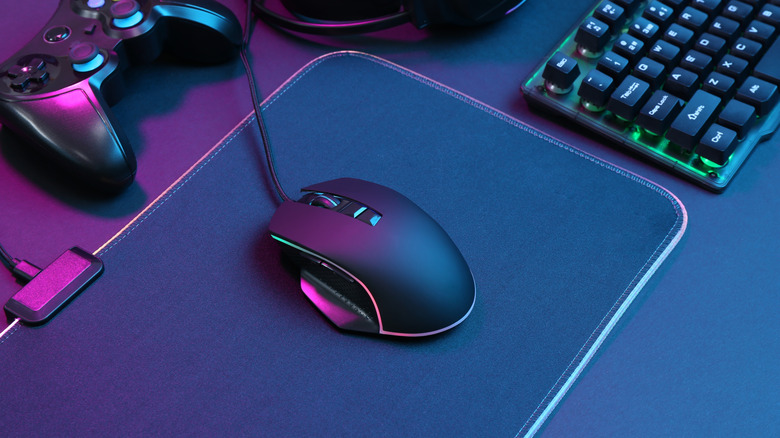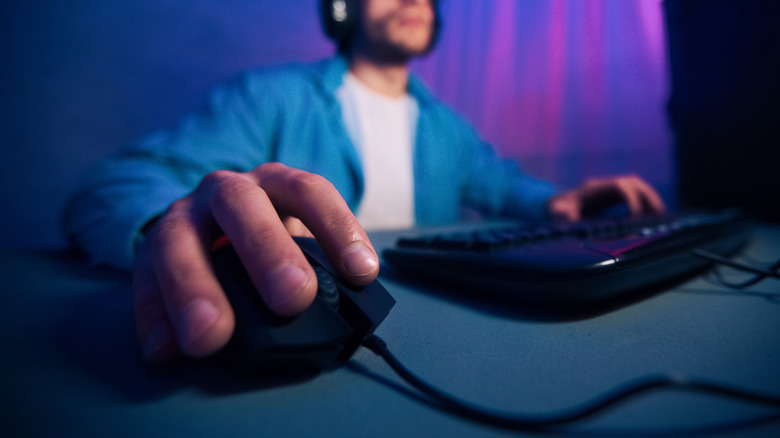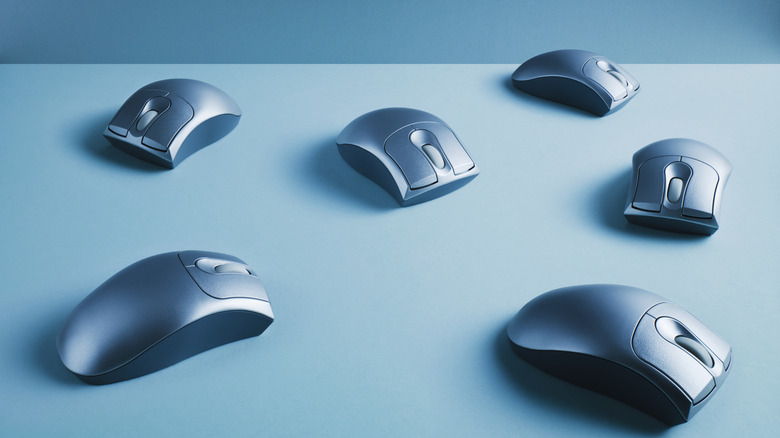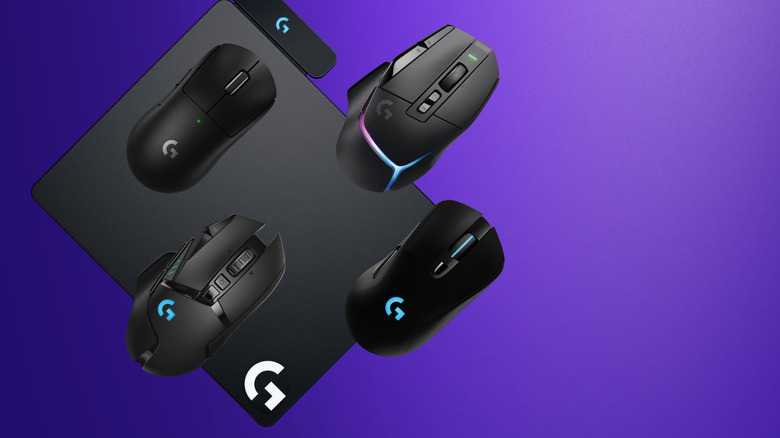Wired Vs Wireless Mice: Which Is Better For Gaming?
We may receive a commission on purchases made from links.
If you're a PC gamer, you've never had such a wealth of choice when it comes to peripherals as you do today. There are more specialty gaming mice than ever before, which can make it hard to select the right one. Gaming mouse brands like Logitech, Razer, and Corsair tempt potential customers with promises of mice that are ergonomic, lightweight, and speedy, but it's hard to know which promises will actually help you get more headshots and which are marketing fluff.
One of the most crucial choices you'll make when purchasing a mouse is the option of wired or wireless. The benefits to both seem clear at first. A wired mouse will never die on you, but will require you to deal with the weight of a cable, which can interfere with your gaming in some scenarios. Alternatively, a wireless mouse might need a charge every so often, but the freedom of movement is unparalleled. However, things get a lot more complex once you start to factor in stats that matter to hardcore gamers, such as milliseconds of latency that can make or break split-second maneuvers, or dots per-inch (DPI) that determines how precisely you can make in-game movements.
If you find yourself getting bogged down in the minutiae of wired versus wireless mice, this article is the resource for you. We'll cover why one type of mouse is generally considered best, but we'll also break down the different specs you should be looking at, as well as discuss the other options to consider. So, let's parse the differences between wired and wireless mice to help you choose the best gaming mouse for you.
Wired mice are more reliable for gaming
While wireless mice from major gaming mouse brands can certainly work for non-competitive games that don't require lightning quick reflexes, pro gamers may be more comfortable with a wired mouse. The best wired mice are likely to perform slightly better than the best wireless mice. Most of this comes down to latency. You want your inputs to take in-game effect as closely to when you click as possible, and wires simply take less time to transmit that data than a wireless connection does. Moreover, wired mice are more reliable. Even a wireless mouse with a very low latency connection could experience a sudden connection issue. Even if the issue resolves itself after only a few moments, that could be the difference between a win and a loss. With that said, wireless gaming mice continue to get better, and many wireless mice from the best gaming mouse brands will work brilliantly in all but the most competitive environments.
However, it's also important to understand that just because a mouse is wired doesn't automatically make it good for gaming. You should examine a mouse's spec sheet before purchasing, to make sure it meets your needs for the specific games you play. While even the simplest and cheapest mouse might work just fine for games like "Baldur's Gate 3," which is turn-based and doesn't rely on player reflex, you'll need a much more specialized mouse for a competitive shooter like "Valorant." So, let's talk about a few mouse specs, starting with polling rates and dots per-inch (DPI), and then continuing on to other factors like Bluetooth and 2.4GHz wireless latency.
Understanding polling rates and DPI
Two of the most important mouse specs are dots per-inch (DPI) and polling rate. Let's begin with the former, which describes how many pixels (those are the "dots") the cursor will move across a screen for each inch the mouse is moved in physical space. The higher your display's resolution, the more this matters. Since, for example, a 4K display has roughly four times the number of pixels of a 1080p display, a cursor will be slower on the higher resolution screen. There is also the more objective metric of counts per-inch (CPI), which measures the movement of the actual mouse sensor; it's a more useful metric, but is less often used in marketing copy.
Meanwhile, polling rate is arguably more important. This refers to the number of times a mouse reports data to the computer every second, and you need a relatively high polling rate to make sure every input is registered, especially in twitchy games where you might be running, shooting, and using other actions at the same time. However, although you'll often see gaming mice advertise polling rates in the multiple thousands, 1,000 Hz is considered perfectly acceptable for gaming, and there are diminishing returns as you go higher.
These are specs you should pay attention to when purchasing a gaming mouse, as they ultimately matter more than whether the mouse is wired or wireless. For instance, a wired mouse with too low a polling rate will probably be worse for gaming than a wireless one with a high polling rate. However, you should also check for latency specs, such as Logitech's claimed 1ms report time on its Lightspeed wireless mice, such as the G502 Lightspeed.
2.4GHz is the best wireless connection for gaming mice
If you are planning to buy a wireless gaming mouse, you should note the difference between Bluetooth and 2.4GHz connections. The former usually requires the user to pair the mouse to the computer as if it were a pair of wireless headphones, while the latter is usually accomplished via a small dongle connected to the computer's USB port. However, Bluetooth tends to have much higher levels of latency than 2.4GHz connections, as you probably know if you've ever watched a movie with Bluetooth headphones and noticed the audio is out of sync with the video.
Many gaming mice, such as the Razer Naga V2 Pro, include both Bluetooth and 2.4GHz options for maximum convenience. However, for any game that requires real time reactions and reflexes, you should use the 2.4GHz dongle rather than the Bluetooth.
Realistically, unless you're trying to reach the top echelons of "Counter-Strike" players, or carry your raiding fireteam in "Destiny 2," you can probably get away with using Bluetooth. However, if you experience lag or Bluetooth connection issues problematic enough to ruin your gameplay, it is recommended that you switch to a 2.4GHz or wired connection. Additionally, a 2.4GHz connection works best when the receiver and mouse are close together. You should ensure a line of sight between the two for the best connection and performance.
Hybrid mice: another solid option
Since one of the main weaknesses of a wireless gaming mouse is the possibility that it could die on you in the middle of an important moment during your game, one great option you can try is a wireless mouse with an inductive charging mousepad. You can find such systems from companies including Logitech and Corsair. They're a great middle ground between wired and wireless mice, ditching the cable to free up your mouse movements while providing limitless battery life.
As an example of this type of hybrid mouse, let's take a look at the Logitech G Powerplay, a charging mouse pad compatible with select Logitech wireless gaming mice. It comes with both a fabric and hard plastic mouse pad to accommodate for different gaming styles. Cleverly, the wireless receiver is built into the charging pad, which helps to improve the stability of your mouse connection and bring it closer to wired performance. Another similar product is the Corsair MM1000 Mouse Pad. However, whereas the Logitech G Powerplay charges the mouse across the entire surface of the pad, the Corsair MM1000 only charges compatible mice in a specific spot at the top corner of the pad, meaning you can't game and charge at the same time.




